Freediving
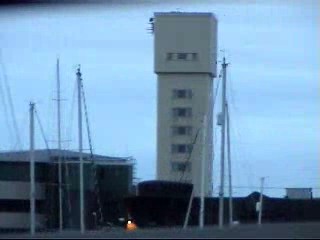 What is freediving?
What is freediving?
Snorkelling with a death wish?
Russian Roulette with fins?
"If you don't need it don't take it" drawn to its logical
conclusion?
I did not know and when I want to know about something I normally find somebody
who teaches it and get them to teach me. Then, at worse, I can decide I did not
like it after all but whatever happens I do know what I am talking about.
STOP! Nigel. Get a grip. It is the middle of winter and you want a
freediving course?
But I have the internet so a quick search and...
Bingo. Freediving courses taught by Howard Jones, the man who organises
big competitions and things and publishes Freediver Magazine. He teaches at
the SETT in Gosport.
Now I have dived the SETT, the Submarine Escape Training Tower, before. It is a
ten storey building with a 27 meter, that is 100 feet deep, pool of warm water
in it. Navy divers teach submariners to escape from the dummy submarine at
ground level and get to the surface on the tenth floor alive. Since the
instructors can spend up to eight hours a day in the pool no suit could keep
them warm so the simple solution is to arrange for a tank in which they will
not get cold. 31°C said my dive computer in shock after 6°C at
Stoney Cove the weekend before.
Day One
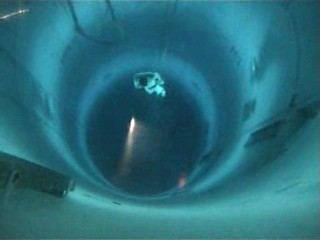 Adrian, aka AJ my son, and I turned up at 8.30 on the Saturday and the MOD's
security people checked us in and gave us passes and things. We did the
obligatory safety lecture, went up the lift, changed, up some more and we are
at the tank top.
Adrian, aka AJ my son, and I turned up at 8.30 on the Saturday and the MOD's
security people checked us in and gave us passes and things. We did the
obligatory safety lecture, went up the lift, changed, up some more and we are
at the tank top.
The SETT is amazing. It does not matter how many times you do it, when you walk
up to it and dangle your fingers in the water you are surprised how warm it is.
Howard paired us up and put each pair on a ladder and, as there is only one
rope for every two ladders, you shared a rope with the pair next door.
The SETT had one more card to play as I put on my mask, flopped into the water,
pushed out, turned back to my ladder and looked down. Gulp. I needed a
sudden firm hold on ladder. It is crystal clear and 27 meters deep. Vertigo
grabs at my tummy. Woo. Is that what a mere 27 meters looks like? Calm down.
You are floating. You can not fall. Get a grip man. It passes. I had a touch of
it next morning but that went away much faster that time.
Howard starts with and explanation of oxygen levels and how you need recovery
time. You will only do a serious dive at about 10 minute intervals so your
blood oxygen gets to recover. You will always dive with a buddy who is on the
surface watching for you. You will surface at the side of the tank and hold on.
You will breathe deeply. Once you are sure you are under control you will
signal your buddy OK.
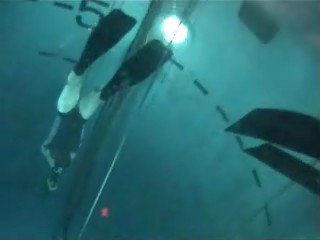 Now we are doing rope drills. Down the rope feet first. Some people, about 30%,
will have a problem clearing their ears head down so we start like this. Down
then back up the rope. Clear your ears early and often. Do not push your ears.
Ears are the limit on freediving. You will get to dive deeper by learning new
ways of clearing your ears. You set records by inventing creative new ways to
clear. Adrian is a bit bunged up and one ear is giving trouble. That limited
him all weekend but he has been diving long enough to be careful.
Now we are doing rope drills. Down the rope feet first. Some people, about 30%,
will have a problem clearing their ears head down so we start like this. Down
then back up the rope. Clear your ears early and often. Do not push your ears.
Ears are the limit on freediving. You will get to dive deeper by learning new
ways of clearing your ears. You set records by inventing creative new ways to
clear. Adrian is a bit bunged up and one ear is giving trouble. That limited
him all weekend but he has been diving long enough to be careful.
We are going to work up. This gets your body used to breath holding. Not deep
and do not worry about how long. Come up when you feel like it and your buddy
will time you.
Apparently you body gets the message that every ten minutes or so it is going
to be called upon to dive and it puts things in place. We just drop down the
rope and wait at 5ish and come back.
53 seconds. Heck it felt like ages. 47 seconds. But I thought it would be
longer. 57 seconds. Well at least all the other newbies are complaining that
they expected to do more time. Howard makes encouraging noises. Adrian is still
having trouble with his ears.
We are getting into the swing of it when Howard calls tea break. I am just
about to dive so I just try and pop one in. It is awful. Shorter than nothing
and when I surface Howard is leaning on the edge laughing at me. I rushed it.
It does not work that way. He is horribly right.
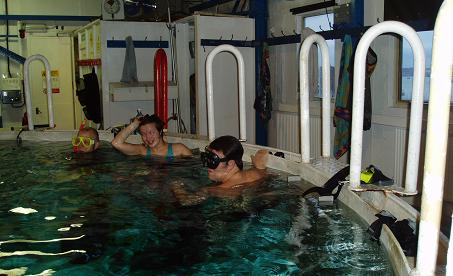 After tea we start to build up the depth. The Uwatec depth timer is not reading
so I switch to the VR3 but it has not got a max depth reading on the display.
Still I have the Reefnet Sentinel Pro logger in my pocket. I set it to record
at one second intervals. Hopefully it is keeping a record.
After tea we start to build up the depth. The Uwatec depth timer is not reading
so I switch to the VR3 but it has not got a max depth reading on the display.
Still I have the Reefnet Sentinel Pro logger in my pocket. I set it to record
at one second intervals. Hopefully it is keeping a record.
Creep it down and start to turn to go head first. Fortunately we all seem to be
in the 70% group and we can clear our ears head down.
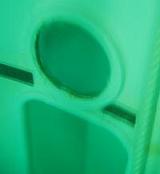 There are dashed lines round the tank at 5 meter intervals so we can read the
depth. Below the 5m line there is an alcove called a blister. We are not
supposed to go in there said the safety brief. It's basically a hole in the
side of the tank where an diver can put himself with his head in a bubble of
air. We can see the other side of one in the tea room with its gas feeds. At
ten meters there is a metal rectangular frame to keep our rope from flapping
about and below that an airlock door.
There are dashed lines round the tank at 5 meter intervals so we can read the
depth. Below the 5m line there is an alcove called a blister. We are not
supposed to go in there said the safety brief. It's basically a hole in the
side of the tank where an diver can put himself with his head in a bubble of
air. We can see the other side of one in the tea room with its gas feeds. At
ten meters there is a metal rectangular frame to keep our rope from flapping
about and below that an airlock door.
Coming back up from 20 meters I scrape through the rope restraint and clunk
myself. As I hit the surface several people tell me I dropped something.
Dropped? I? Oh my watch. Chris the safety diver says "Don't worry. I'll get
it". Now we get to see how it should be done. Breathe up. Chill out. Relaxed.
Gently flip to head down and pull effortlessly down the centre rope. From the
centre to the bottom below us and he is on his way back up. He has found it.
Going back for the pin that held the strap on was just showing off but he found
that too.
Lunch and then we are moving to fins.
Now freediving fins are big. They have to be oxygen efficient as you only have
so many kicks in you so we put on these great things. You need to kick them so
that you put a 90 degree bend in them insists Howard. He is not kidding. I can
lift my chest out of the water but ARGHHHH! instant cramp in both
calves. It is the forward kick. The fins are using muscles I do not usually
exercise. The action is like kicking a ball and whatever muscle pulls my toes
up isn't happy. I know they are great fins but I can not afford to have my
legs go offline deep so I switch back to my booties and scuba fins.
Actually looking at bits of Adrian's video later I can see a huge difference
between the finning style of the instructors and me. My knees are bent and my
ankles are bent and my fins point back, their legs and fins are one long
straight thing. Hence I have a wimpy little kick and they have an enormous
sweep.
We spend the afternoon duck diving, my duck dive is awful, and generally
learning to dive vertically down and vertically up and staying close to the
rope in case you loose a fin or get cramp. Also we sharpen up the trick of
always surfacing and checking in with your buddy. Look at the diver's eyes when
he surfaces. The Partial pressure of oxygen is falling as he rises and he is at
risk of a shallow water blackout, a Samba in Freediving slang. In
a contest a Samba is zero points but on your own it is very dangerous. This is
why you have a buddy and you virtually place yourself in their hands as you
ascend so all they have to do is grab.
We were exhausted. We crawled of for a shower and were very thankful to be able
to leave our kit where it lay. Swap mobile numbers as they know a good Indian
so we are going for a curry. It was a good curry too. I slept from about half
past nine through until the alarm at seven thirty despite all the Coca-Cola I
had drunk.
Day Two
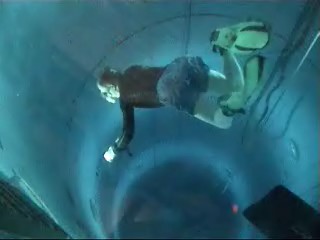 We arrived a bit later than the day before. It is always that way when you
have ten minutes travel time rather than an hour and a half. We picked up our
passes, changed and put ourselves in the water. Gosh it is warm. Eeek it is
deep. It is work up time. Just a mask and down to 5 meters on the rope. Pause
with fingers a ring round the rope. Yes I am positive. If I was wearing a wet
suit I should use weights to be neutral at 6 meters. I would be on my way up if
I waited but it would be slow. Reach up and pull and let the rope slide through
my hand and as I start to slow pull again. Keep it oxygen efficient. Grip the
edge of the tank. Breathe, breathe, breathe, OK Adrian. Tick. 5 meters. Note
the time on the monitor screens for the surface interval.
We arrived a bit later than the day before. It is always that way when you
have ten minutes travel time rather than an hour and a half. We picked up our
passes, changed and put ourselves in the water. Gosh it is warm. Eeek it is
deep. It is work up time. Just a mask and down to 5 meters on the rope. Pause
with fingers a ring round the rope. Yes I am positive. If I was wearing a wet
suit I should use weights to be neutral at 6 meters. I would be on my way up if
I waited but it would be slow. Reach up and pull and let the rope slide through
my hand and as I start to slow pull again. Keep it oxygen efficient. Grip the
edge of the tank. Breathe, breathe, breathe, OK Adrian. Tick. 5 meters. Note
the time on the monitor screens for the surface interval.
Number two so Zen out, the world goes away, breathe up and go. Past the blister
at 5m, past the airlock at 10 and stop below the 10m line. Pause. This time I
am neutral. Maybe the tiniest bit positive but not going anywhere significant.
Pull and slide. This is good. Better than yesterday. I must have learnt
something. Surface. Hold the side. Turn to Adrian as I breathe so he can see my
eyes. Signal OK.
Number three comes after another ten minutes. The plan is 15. Zen out. Heart
rate at rest. Breathe up. Get the max in and go. 15 meters, well 16 as I want
the saltwater computer to log 15. Pause. I am negative. I'm sinking. Pull and
glide. Pull and glide. Coming through 5 the pressure to breathe is getting a
bit serious. Surface. Hold the side. Breathe at Adrian, Breathe, Breathe, OK.
Hey this feels good.
Number four. I have stretched the surface interval and I am chilled out. This
is going to match yesterday's maximum. Breathe up and go. Faster down as I am
now ear clearing virtually without pause. 20 meters plus one for the fresh
water and pull straight back up. Through 15, through 10, Grief I want to
breathe. Just seconds. I am there. Do the drill. Breathe. Turn to my buddy.
Breathe. Breathe. OK.
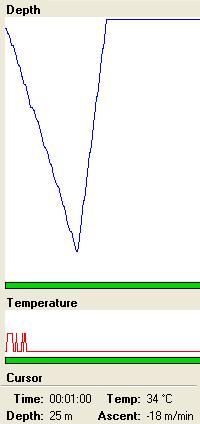 Number five. 25 meters is the plan. A new maximum. Reassure myself inside my
head. Remember you can pull out at any time. Just switch to going up. Zen out.
Heartbeat down. Breathe up. Grab every bit of air I can get as it will not be
uncomfortable at depth. Go. Down down. 20m you can turn here and nobody will
think anything bad because nobody knows. I want to breathe but I will keep
going. 25m give it that extra meter of stretch to get 25 on the computer. Heck
I am just a couple of meters off touching the bottom. Should I go for it? It
would be great to do it. But I can not clear my ears. My mask is squeezing. All
that air I forced in has compressed to nothing. Plan the dive - dive the
plan fool. Pull the rope. Glide. Pull. Glide. 20m. Pull. Oh heck it is 15m
and I am on the edge. I have over done this one. I should not have hesitated at
the bottom. I still have 5 stories of this building to climb yet. 10m this
hurts but I am positive now so I am going up regardless. 5 and the blister.
Pull. I can see the splice in the rope so hands off and as I surface they latch
smoothly onto the side - made it - breathe.
Number five. 25 meters is the plan. A new maximum. Reassure myself inside my
head. Remember you can pull out at any time. Just switch to going up. Zen out.
Heartbeat down. Breathe up. Grab every bit of air I can get as it will not be
uncomfortable at depth. Go. Down down. 20m you can turn here and nobody will
think anything bad because nobody knows. I want to breathe but I will keep
going. 25m give it that extra meter of stretch to get 25 on the computer. Heck
I am just a couple of meters off touching the bottom. Should I go for it? It
would be great to do it. But I can not clear my ears. My mask is squeezing. All
that air I forced in has compressed to nothing. Plan the dive - dive the
plan fool. Pull the rope. Glide. Pull. Glide. 20m. Pull. Oh heck it is 15m
and I am on the edge. I have over done this one. I should not have hesitated at
the bottom. I still have 5 stories of this building to climb yet. 10m this
hurts but I am positive now so I am going up regardless. 5 and the blister.
Pull. I can see the splice in the rope so hands off and as I surface they latch
smoothly onto the side - made it - breathe.
Bang I am clamped to the side of the tank.
"Breathe" says Chris the safety diver into my ear. His arms are hooked round me
and his knee is under my bottom. I am not going anywhere. I breathe down.
"Good call" I confess. "I don't think I lost it but I overcooked it a
bit."
Chris waits until he is sure I am settled and releases me.
"I just felt it looking at your eyes as you came up" he said and moved off. I
look down. The 25m ring is visible but it's a long, long way away.
After that I noticed the safety divers more. You could see them monitoring,
moving around to be in the right place. They never interfered but they knew
what was going on.
The plot from the Sentenel Pro is on the right (the VR3 logs every 10 seconds
which is not much use but it never pretended to be a freedive computer). The
logger switched on at 1 meter, logged 60 seconds to 25 meters then 25 seconds
back up. Say one and a half minutes and 50 meters covered all on arm power. I
would like to go back and do that again head first. That worked better for me
but I was nervous of doing it on the rope until after I had tried it with
fins.
Right. I have clearly set myself a depth limit there. Where are my fins?
Again I get the twinges in my calves so it was back to my old scuba fins and I
did stick to a 15 meter limit. Frankly I was faster down and faster up so as
I am going back to the gym to revise for my medical exam in June I will work on
my kick muscles. In fact I will order some big freedive fins.
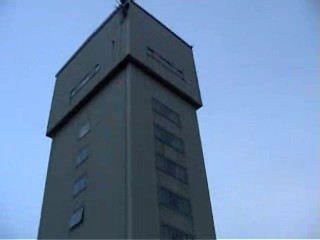 After lunch Howard gathered the newbies together and talked us through the
procedures and finished the day with some rescue demonstrations. One tool was a
very standard Buddy self inflator DSMB but with a very big 0.4L bottle. This
will fully inflate the bag at 80m and give 9Kgs of lift all the way up.
Freedivers have a very different attitude to ascent rates to scuba divers. We
say slow is good and discuss maximum rates and tricks to stay
slow while they have no maximum but think slow is bad. If you fin hard it hurts
but if you are too slow you black out. It is not really a choice is it?
After lunch Howard gathered the newbies together and talked us through the
procedures and finished the day with some rescue demonstrations. One tool was a
very standard Buddy self inflator DSMB but with a very big 0.4L bottle. This
will fully inflate the bag at 80m and give 9Kgs of lift all the way up.
Freedivers have a very different attitude to ascent rates to scuba divers. We
say slow is good and discuss maximum rates and tricks to stay
slow while they have no maximum but think slow is bad. If you fin hard it hurts
but if you are too slow you black out. It is not really a choice is it?
Well that was it. Adrian gave up on his ears and got out the video camera while
I carried on diving to the 15 meter range. We probably have an excuse to go
back and do the course again and put what we learnt into practice. I will work
on my finning and do the breathing exercises. Interestingly in the final
debrief my incident in the morning was promoted to a Samba. I am not sure if
that means I am now somehow initiated. I do not think I blacked out but I am
just an amateur. If Howard says I did I might as well put it in my diary and be
pleased not to have to do it again.
That was it. We were exhausted and it was a long drive home.
I suppose you want some links...
http://www.freediver.co.uk/ the magazine
The course description
and the sales page.
Of course the next time somebody says that a 3L pony is not enough to get you
back from 30m I am allowed to laugh.
Pictures by Adrian Hewitt taken from his video. Thanks.

by Nigel Hewitt
 What is freediving?
What is freediving? Adrian, aka AJ my son, and I turned up at 8.30 on the Saturday and the MOD's
security people checked us in and gave us passes and things. We did the
obligatory safety lecture, went up the lift, changed, up some more and we are
at the tank top.
Adrian, aka AJ my son, and I turned up at 8.30 on the Saturday and the MOD's
security people checked us in and gave us passes and things. We did the
obligatory safety lecture, went up the lift, changed, up some more and we are
at the tank top. Now we are doing rope drills. Down the rope feet first. Some people, about 30%,
will have a problem clearing their ears head down so we start like this. Down
then back up the rope. Clear your ears early and often. Do not push your ears.
Ears are the limit on freediving. You will get to dive deeper by learning new
ways of clearing your ears. You set records by inventing creative new ways to
clear. Adrian is a bit bunged up and one ear is giving trouble. That limited
him all weekend but he has been diving long enough to be careful.
Now we are doing rope drills. Down the rope feet first. Some people, about 30%,
will have a problem clearing their ears head down so we start like this. Down
then back up the rope. Clear your ears early and often. Do not push your ears.
Ears are the limit on freediving. You will get to dive deeper by learning new
ways of clearing your ears. You set records by inventing creative new ways to
clear. Adrian is a bit bunged up and one ear is giving trouble. That limited
him all weekend but he has been diving long enough to be careful. After tea we start to build up the depth. The Uwatec depth timer is not reading
so I switch to the VR3 but it has not got a max depth reading on the display.
Still I have the Reefnet Sentinel Pro logger in my pocket. I set it to record
at one second intervals. Hopefully it is keeping a record.
After tea we start to build up the depth. The Uwatec depth timer is not reading
so I switch to the VR3 but it has not got a max depth reading on the display.
Still I have the Reefnet Sentinel Pro logger in my pocket. I set it to record
at one second intervals. Hopefully it is keeping a record. There are dashed lines round the tank at 5 meter intervals so we can read the
depth. Below the 5m line there is an alcove called a blister. We are not
supposed to go in there said the safety brief. It's basically a hole in the
side of the tank where an diver can put himself with his head in a bubble of
air. We can see the other side of one in the tea room with its gas feeds. At
ten meters there is a metal rectangular frame to keep our rope from flapping
about and below that an airlock door.
There are dashed lines round the tank at 5 meter intervals so we can read the
depth. Below the 5m line there is an alcove called a blister. We are not
supposed to go in there said the safety brief. It's basically a hole in the
side of the tank where an diver can put himself with his head in a bubble of
air. We can see the other side of one in the tea room with its gas feeds. At
ten meters there is a metal rectangular frame to keep our rope from flapping
about and below that an airlock door. We arrived a bit later than the day before. It is always that way when you
have ten minutes travel time rather than an hour and a half. We picked up our
passes, changed and put ourselves in the water. Gosh it is warm. Eeek it is
deep. It is work up time. Just a mask and down to 5 meters on the rope. Pause
with fingers a ring round the rope. Yes I am positive. If I was wearing a wet
suit I should use weights to be neutral at 6 meters. I would be on my way up if
I waited but it would be slow. Reach up and pull and let the rope slide through
my hand and as I start to slow pull again. Keep it oxygen efficient. Grip the
edge of the tank. Breathe, breathe, breathe, OK Adrian. Tick. 5 meters. Note
the time on the monitor screens for the surface interval.
We arrived a bit later than the day before. It is always that way when you
have ten minutes travel time rather than an hour and a half. We picked up our
passes, changed and put ourselves in the water. Gosh it is warm. Eeek it is
deep. It is work up time. Just a mask and down to 5 meters on the rope. Pause
with fingers a ring round the rope. Yes I am positive. If I was wearing a wet
suit I should use weights to be neutral at 6 meters. I would be on my way up if
I waited but it would be slow. Reach up and pull and let the rope slide through
my hand and as I start to slow pull again. Keep it oxygen efficient. Grip the
edge of the tank. Breathe, breathe, breathe, OK Adrian. Tick. 5 meters. Note
the time on the monitor screens for the surface interval. Number five. 25 meters is the plan. A new maximum. Reassure myself inside my
head. Remember you can pull out at any time. Just switch to going up. Zen out.
Heartbeat down. Breathe up. Grab every bit of air I can get as it will not be
uncomfortable at depth. Go. Down down. 20m you can turn here and nobody will
think anything bad because nobody knows. I want to breathe but I will keep
going. 25m give it that extra meter of stretch to get 25 on the computer. Heck
I am just a couple of meters off touching the bottom. Should I go for it? It
would be great to do it. But I can not clear my ears. My mask is squeezing. All
that air I forced in has compressed to nothing. Plan the dive - dive the
plan fool. Pull the rope. Glide. Pull. Glide. 20m. Pull. Oh heck it is 15m
and I am on the edge. I have over done this one. I should not have hesitated at
the bottom. I still have 5 stories of this building to climb yet. 10m this
hurts but I am positive now so I am going up regardless. 5 and the blister.
Pull. I can see the splice in the rope so hands off and as I surface they latch
smoothly onto the side - made it - breathe.
Number five. 25 meters is the plan. A new maximum. Reassure myself inside my
head. Remember you can pull out at any time. Just switch to going up. Zen out.
Heartbeat down. Breathe up. Grab every bit of air I can get as it will not be
uncomfortable at depth. Go. Down down. 20m you can turn here and nobody will
think anything bad because nobody knows. I want to breathe but I will keep
going. 25m give it that extra meter of stretch to get 25 on the computer. Heck
I am just a couple of meters off touching the bottom. Should I go for it? It
would be great to do it. But I can not clear my ears. My mask is squeezing. All
that air I forced in has compressed to nothing. Plan the dive - dive the
plan fool. Pull the rope. Glide. Pull. Glide. 20m. Pull. Oh heck it is 15m
and I am on the edge. I have over done this one. I should not have hesitated at
the bottom. I still have 5 stories of this building to climb yet. 10m this
hurts but I am positive now so I am going up regardless. 5 and the blister.
Pull. I can see the splice in the rope so hands off and as I surface they latch
smoothly onto the side - made it - breathe. After lunch Howard gathered the newbies together and talked us through the
procedures and finished the day with some rescue demonstrations. One tool was a
very standard Buddy self inflator DSMB but with a very big 0.4L bottle. This
will fully inflate the bag at 80m and give 9Kgs of lift all the way up.
Freedivers have a very different attitude to ascent rates to scuba divers. We
say slow is good and discuss maximum rates and tricks to stay
slow while they have no maximum but think slow is bad. If you fin hard it hurts
but if you are too slow you black out. It is not really a choice is it?
After lunch Howard gathered the newbies together and talked us through the
procedures and finished the day with some rescue demonstrations. One tool was a
very standard Buddy self inflator DSMB but with a very big 0.4L bottle. This
will fully inflate the bag at 80m and give 9Kgs of lift all the way up.
Freedivers have a very different attitude to ascent rates to scuba divers. We
say slow is good and discuss maximum rates and tricks to stay
slow while they have no maximum but think slow is bad. If you fin hard it hurts
but if you are too slow you black out. It is not really a choice is it?